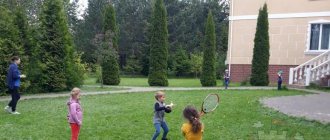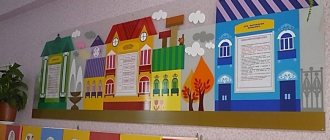Statistics
According to the Russian Ministry of Internal Affairs, in January–July 2016, 8.1 thousand people died in road accidents.
In these road accidents, 254 children died and more than 8,000 children were injured. According to experts, the cause of road accidents is drivers ignoring traffic rules. However, responsibility for road safety also lies with pedestrians, including parents of preschool children. The younger the child, the less sensitive he is to danger; the baby does not always know and understand what exactly threatens him, what consequences this or that behavior may entail. That is why it is very important for mothers, fathers, and other close adults to pay increased attention to the safety of children, and teachers should promptly inform parents about methods and means of preventing accidents. One of the forms of work in this direction is consultation for parents in kindergarten on traffic rules.
The success of speaking to parents of students depends on how the teacher prepares for the consultation, whether he can interest the audience and draw attention to the problem. Preparation of the consultation begins with studying the age characteristics of preschoolers from the point of view of children’s perception of the road and moving vehicles.
How kids see and imagine the roadway
A child’s field of vision is narrower than that of an adult, so it is difficult for a preschooler to determine the distance to a rapidly approaching car. Moreover, the child is not able to calculate the speed of traffic.
Children of early, junior and even middle preschool age do not perceive a car as something potentially dangerous. The kid rushes after the ball that has rolled out onto the road, not thinking at all about moving cars. The main thing for the child is to return the toy. He does not understand that trying to catch the ball may be his last. Therefore, the sooner work begins on children learning the rules of the road, the greater the likelihood of saving children from harm. The teacher tells moms and dads about all this, conducting a consultation on traffic rules for parents.
Simple safety rules when traveling by car
– Children under 12 years of age must sit in the back seat of the car unless there is a special child restraint in the front seat.
– All safety devices must be correctly selected according to the age of the child. It is very important to ensure that your child is properly restrained for their size and weight.
– For children under 2 years of age there is a special seat that is attached to the back seat and faces the rear window. In the event of an accident, it reduces the load on the child’s neck (the most vulnerable spot in a collision) by 90%.
– For children from 3 to 8 years old, it is recommended to use a child seat with a special seat belt system. It reduces the possibility of injury by 70%. If your vehicle is equipped with an airbag, never install a child seat in the front seat.
– For children 9–12 years of age, it is recommended to use a booster seat or adapter that elevates the child's body so that the seat belt fits correctly and securely, protecting them, across the chest and down through the hips (not across the neck and abdomen). The closer the belt sits to the body, the better the protection.
– Wear your seat belts, even if your vehicle is equipped with air bags. By wearing seat belts, you reduce the risk of fatal accidents by 45%.
– A head-on collision at a speed of 50 km/h is equivalent to falling from the third floor of a building. Therefore, by not fastening your child with seat belts, you seem to be allowing him to play on the balcony without railings!
– Teach your children good habits and make them feel responsible. Explain to them how to behave and set a good example.
What and how to tell children about traffic rules
Visual-figurative thinking dominates in preschoolers, so a literal interpretation of the Rules of the Road with a large number of abstract theoretical calculations is unacceptable.
In the second younger group, children are told and shown what a street, sidewalk, or one-way road is. Children are also introduced to types of transport (cars and trucks, buses, trolleybuses, trams), and are told about the work of a driver, traffic lights (red and green signals).
Teachers of the middle group introduce children to two-way traffic on the road, yellow traffic lights, traffic controller gestures, the “Pedestrian Crossing” road sign, ground and underground crossings, classification of modes of transport (water, air, land). They explain how to move along the sidewalk (on the right side) and behave in public transport.
In the senior and preparatory groups, students’ ideas about the road (center line) are expanded. Future schoolchildren are shown road signs (“Crossroads”, “Food station”, “Telephone”, “Medical assistance”, “Parking”, “Pedestrian traffic is prohibited”, “Entry is prohibited”, “Public transport stop”), and the rules are reinforced with the children crossing the roadway.
When working with children it is appropriate to:
- personal example;
- visibility (posters, illustrations);
- reading fiction;
- games.
The teacher informs parents about the content of teaching preschoolers on the topic “Road Rules” in a specific age group, offers handouts (memos, brochures, diagrams), and demonstrates presentations. The teacher talks in detail about how to study at home. The listed methods are appropriate and effective when it comes to consulting parents on traffic rules in kindergarten according to the Federal State Educational Standard.
Personal example
When going somewhere with a child, parents:
- holding the baby's hand;
- while leading the baby along the sidewalk, they themselves are closer to the roadway, and the child walks nearby;
- cross the road when the traffic light is green;
- at the intersection, first they look to the left, then to the right, then to the left again, and only after that, if the cars are far away, they go out onto the roadway and calmly, without fuss, head to the opposite side of the street;
- they don’t cross the road because “it’s closer,” even if they’re in a hurry, they don’t climb over barriers;
- do not catch up with the departing bus, trolleybus, tram or minibus;
- when crossing the road after getting out of the vehicle, the bus, trolleybus and minibus go around from behind, and the tram - from the front;
- do not enter the roadway due to an obstacle (vehicle, bush, fence, etc.);
- in the dark, wear reflective elements (flickers) on yourself and your child;
- They talk through the actions being performed and draw the child’s attention to the need to follow traffic rules.
When transporting a child by car:
- drive a car, observing the rules for drivers;
- children are transported in car seats;
- adults and children get into and out of the car only from the sidewalk.
When disembarking from public transport, an adult leaves first. Rules of behavior on the road are drawn up in the form of a list, table, diagram, which should have a name. For example, consultation on traffic rules for parents “Children’s safety is the concern of adults.”
Visibility
Pictures and posters “Pedestrian Reminder”, “Traffic Light”, “Be Attentive!”, “Road ABC”, etc. help children learn the rules of the road. You can buy a ready-made poster or draw it with your child at home.
Visual materials will not be useful if they hang in the room “in the background.” The teacher draws the attention of parents to the need to talk with the child about the content of the picture, poster, discuss what is depicted, whether the character is doing the right thing, and how to behave in such a situation.
Books on traffic rules for preschoolers
for reading to children of primary preschool age :
- B. Zakhoder “Chauffeur”;
- N. Kalinina “How the guys crossed the street”;
- A. Barto “Truck”, etc.
Children four to five years old are read stories by A. Dorokhov from the book “Green, Yellow, Red”, poems by V. Pishumov “Song about Rules”, S. Mikhalkov “Bad History”, V. Kozhevnikov “Traffic Light”, etc.
Pupils of the senior and preparatory groups get acquainted with the working life of S. Mikhalkov’s hero Uncle Styopa, master the gestures of a traffic controller, listening to V. Dorokhov’s story “The Influential Wand” and V. Semerin’s poem “Forbidden - Permitted”, learn to be exemplary pedestrians and responsible passengers.
An important point when working with parents: do not forget to inform them that after reading a book you should discuss its contents with your child.
Traffic rules games for preschoolers
Play is the leading activity in preschool childhood. The full development of the child, the preschooler’s mastery of vital skills and abilities, takes place precisely in it. Here are some examples of games that a teacher can recommend to parents for studying at home.
Younger preschoolers
The purpose of the didactic game “Traffic Light” is to teach children to recognize traffic light signals. A mock-up of a traffic light with empty holes and two sets of circles in red and green are prepared in advance. The adult gives one set to the child, and keeps the other for himself.
The adult inserts one of the circles into the corresponding hole of the model and invites the child to determine which signal is on (the child picks up a circle of the same color), and also explain what the pedestrian should do (red - stand still, green - look around and walk).
Children from 4 to 5 years old
You can also play “Traffic Light” with kids of this age, just add a yellow signal. No less interesting is “Word Game” . An adult offers to clap your hands when words and phrases related to the following are heard:
- to a traffic light (standing at an intersection, standing at home, red light, blue light, yellow light, brown light, helping a pedestrian, hindering a pedestrian);
- to a pedestrian (intersection, crossing, traffic light, body, standing and waiting, steering wheel, sidewalk);
- to the driver (steering wheel, body, wing, rides, motor, flies, wheel, paws, tail);
- to the passenger (bus, trolleybus, pulls up to a stop, bed, stool, stop, shows a ticket).
Senior preschool age
The game “Guess the Sign” will help you consolidate the names and purposes of road signs . An adult places cardboard signs in plain sight and offers to guess the sign based on the description (in random order he talks about the purpose of the signs).
During the consultation, the teacher invites parents to play and takes on the role of facilitator.
Recommendations for the parent corner on traffic rules
Recommendations for parents on traffic rules.
Based on materials from the magazines "Obruch"
Dear parents! Do everything necessary so that trouble does not come to your family. It is known that a person absorbs behavioral norms in the first years of life. His life lessons and the lessons of his parents are the foundation on which the child will rely throughout his life.
Timely teach children the ability to navigate traffic situations, cultivate the need to be disciplined on the street, careful and prudent! Remember, by breaking the traffic rules, you are clearly allowing your children to break them.
When you are on the street with your child, it is useful to explain to him everything that happens on the road with vehicles and pedestrians. For example, why you can’t cross the road at the moment, what rules there are for pedestrians and drivers in this case, what the road signs mean and why they are needed, point out the violators, noting that these people risk getting hit by the wheels of cars.
Teach children:
- Cross the road only in a designated place (at a green traffic light, at a pedestrian crossing, intersection)
- Don't rush when crossing the road
- Cross the road only when there is nothing obstructing your view
- Cross the road, making sure it is completely safe
- Do not cross the road in front of a nearby vehicle
Follow the traffic rules and teach this to your children!
Recommendations for parents. How to teach a child not to get caught
into typical road “traps”.
- The main danger is a stationary car!
A stationary car is dangerous: it can block another car that is moving at high speed, making it difficult to notice the danger in time. You cannot go out onto the road because of parked cars. As a last resort, you need to carefully look out from behind a standing car, make sure that there is no danger, and only then cross the road.
- Do not go around a stationary bus, either in front or behind!
A stationary bus blocks a section of the road along which a car can pass at the moment when you decide to cross it. In addition, people near the bus stop are usually in a hurry and forget about safety. From the stop you need to move towards the nearest pedestrian crossing.
- Know how to anticipate hidden dangers!
A car may unexpectedly drive out from behind a parked car, house, fence, bushes, etc. To cross the road, you need to choose a place where the road is visible in both directions. As a last resort, you can carefully look out from behind the obstacle, make sure that there is no danger, and only then cross the road.
- The car approaches slowly. And yet you have to skip it.
A slow moving car can hide behind a car going at high speed. A child often does not suspect that another car may be hidden behind one car.
- And at a traffic light you can meet danger.
Today on city roads we are constantly faced with car drivers violating traffic rules: driving at high speed, ignoring traffic lights and crossing signs. Therefore, it is not enough to teach children how to navigate when the traffic light is green; it is necessary to make sure that there is no danger. Children often reason like this: “The cars are still standing, the drivers see me and will let me through.” They are wrong.
- Children often run across a “deserted” street without looking.
On a street where cars rarely appear, children run out onto the road without first inspecting it and get hit by a car. Develop in your child the habit of always stopping before going out onto the road, looking around, listening - and only then crossing the street.
- When standing on the center line, remember: there may be a car behind you!
Having reached the center line and stopped, children usually only watch for cars moving on the right side and forget about the cars passing behind them. Frightened, the child may take a step back - right under the wheels of the car. If you had to stop in the middle of the road, you must be extremely careful and not make a single move without making sure it is safe.
- When outside, hold your child's hand tightly!
Being next to an adult, the child relies on him and either does not watch the road at all or does not watch well. An adult does not take this into account. On the street, children are distracted by all sorts of objects and sounds, not noticing a moving car, and thinking that the way is clear, they break away from the hands of an adult and run across the road. When crossing the road, you should hold your child's hand tightly.
- Arches and exits from courtyards are places of hidden danger!
In large cities, places of increased danger are arches through which cars drive out of courtyards onto the roadway. Do not allow a child to run past the arch in front of an adult: he must be held by the hand.
Remember! The child learns the laws of the street, following the example of you, parents, and other adults. Let your example teach disciplined behavior on the street not only to your child, but also to other children. Cross the road, observing the traffic rules.
Advice for parents and motorists.
Mother! Dad! Don't forget to fasten me to the seat!
How often do you see this picture: a child is being transported in a car. The baby is proudly resting in the front seat of the car, next to his happy father, and neither of them is wearing a seat belt! Mothers are more “responsible” in this matter; they do not forget to fasten themselves with a seat belt, and place the baby in the back seat. The child is left to his own devices on the road. In the best case, an adult sits next to the child in the back seat.
Parents, do you not value the lives of your children? When buying a car, car enthusiasts are increasingly paying great attention to the issue of safety: braking system, seat belts, air bags, etc. In an emergency, adults have a chance to survive. And children, in a collision, fly like “corks from a bottle.” Remember that the impact lasts a tenth of a second; overloads during an accident increase your body weight tens of times. Even if a child is held in the arms of an adult, his arms will not be able to develop a force of hundreds of kilograms. And if an adult is not yet wearing a seatbelt during a collision, then colossal overloads will throw him forward too. And he will simply crush the child with himself...
There is only one guarantee of the safety of our children - a special car seat.
Unfortunately, domestic manufacturers do not produce child car seats. And imported seats are not cheap. How to properly install a child seat in a car? It depends on the age of the child. Babies under one year old must ride, reclining and facing backwards! You can turn the child seat in the direction of travel when the child grows so much that his legs begin to rest against the back of the car seat. As a rule, this occurs by two years.
Attention! When using a child car seat, strictly follow the instructions! Consult the store’s sales staff on any questions you may have, because the life of a child is at stake!
The safest place in a car is behind the driver.
Experts advise that you should transport a small passenger there, and if an adult is holding a child in his arms, they recommend sitting sideways on the seat, with your back to the door. Hold the child on your lap with your feet forward.
Remember that paragraph 22.8 of the Road Traffic Regulations states that it is prohibited to transport children under 12 years of age in the back seat of a motorcycle or in the front seat of a car in the absence of a special restraint device.
Take care of the safety of little passengers! Good luck on the roads!







